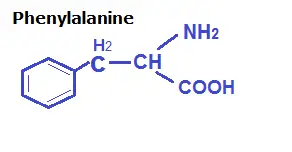Amino acids are the molecules that make up the proteins.
Proteins are the building blocks of the body.
In the body, proteins comprise more than 50% of total body mass.
While the rests are carbohydrates and fats.
The proteins from food & other supplements we consume get broken down into amino acids by the action of enzymes in the digestive system.
These are then absorbed into the blood and supplied to the whole body.
They help the body in building the required protein in the cell by a process known as a translation of mRNA.
What are Essential and Nonessential Amino Acids
The amino acids are scientifically differentiated as essential and nonessential amino acids.
Every amino acid has a carboxylic moiety and an amino group.
Essential amino acids are those which can’t be synthesized inside the body of both humans and animals. They are synthesized only by plants and microbes. Hence one is required to get these essential amino-acids through diet.
Nonessential amino acids: These are the amino acids that are formed inside the body. So, one need not worry if he is getting these amino-acids from external source or diet.
List of Essential amino acids
| Number | Amino acid’s Name |
| 1 (essential in preterm infants) | Arginine |
| 2 | Histidine |
| 3 | Isoleucine |
| 4 | Leucine |
| 5 | Lysine |
| 6 | Methionine |
| 7 | Phenyalanine |
| 8 | Threonine |
| 9 | Tryptophan |
| 10 | Valine |
List of non-essential amino acids

| Number | Name of Amino acid |
| 1 | Alanine |
| 2 | Aspargine |
| 3 | Aspartic Acid |
| 4 | Cysteine |
| 5 | Cystine |
| 6 | Glutamic acid |
| 7 | Glutamine |
| 8 | Glycine |
| 9 | Hydroxyproline |
| 10 | Proline |
| 11 | Serine |
| 12 | Tyrosine |
| 13 (Non-essential in adults) | Arginine |
Of the above amino acids, there are small distinctions.
Aromatic amino acids: These are the ones that have aromatic groups in their molecule. See phenylalanine structure in the above diagram.
 Aromatic rings are the ring-like carbon molecules that are double bond and unsaturated in nature.
Aromatic rings are the ring-like carbon molecules that are double bond and unsaturated in nature.
Examples for such amino acids include
Phenylalanine, tyrosine, tryptophan.

Aliphatic amino acids: These are ones that have aliphatic groups like -CH2- in between carboxylic and an amine moiety. They are the ones excluding aromatic amino acids from the above list of both essential and non-essential ones.
Similarly, some of them have special functional groups unlike others
Example: Sulfur-containing ones; Methionine, cysteine.
Hydroxyl groups containing ones are serine and threonine, contain aliphatic.
The amino acids are zwitterions i.e. they possess both positive and negative charges on the same molecule.
Amino-acids are needed for various biochemical reactions. For this, they are either naturally synthesized or obtained from the diet. Some of the reactions where they are needed include in the formation of proteins, enzymes, different hormones, etc.
In times of starvation, the amino acids are synthesized from stored carbohydrates and fats.
I’m curious why hydroxyproline & cystine are often included in the nonessential 13 amino acids & not in other lists that only include 11. Why do some consider those amino acids to be acids that humans need, but can produce within the body, as nonessential, but others do not include as nonessential amino acids humans process.
There are over 500 amino acids that occur in nature! 21 or so are essential for human life, what matters is which ones the body makes and which ones we need to get from diet!
Jacob Wong
You listed 22 amino acids with ten being the essential ones. But I read from the book “Cell” by Geoffrey M. Cooper that there are only 20 amino acids and not 22. Which fact is correct? 20 or 22?
There are 9 essential amino acids for most people & 13 non-essential for most people. The 10th essential is only for pre-term infants is my understanding, & is listed in both categories with limitations as to its application.
There are 9 essential amino acids for most people & 13 non-essential for most people. The 10th essential Arginine is only for pre-term infants is my understanding, & is listed in both categories with limitations as to its application. My question is why one list says it applies to preterm infants & the other says the Arginine is non-essential for adults. Seems clarification is needed to be clear for whether Arginine is essential or nonessential for full term infants, toddlers & teens.
Thank you. Took a while to find your site. So glad I did.
Most sites only have nine listed essential amino acids, however, I was told I need to make sure I have the ten essential amino acids. Hard to do when one does not know what the tenth essential amino acid is.
Keep up the good work!
A very rich information!